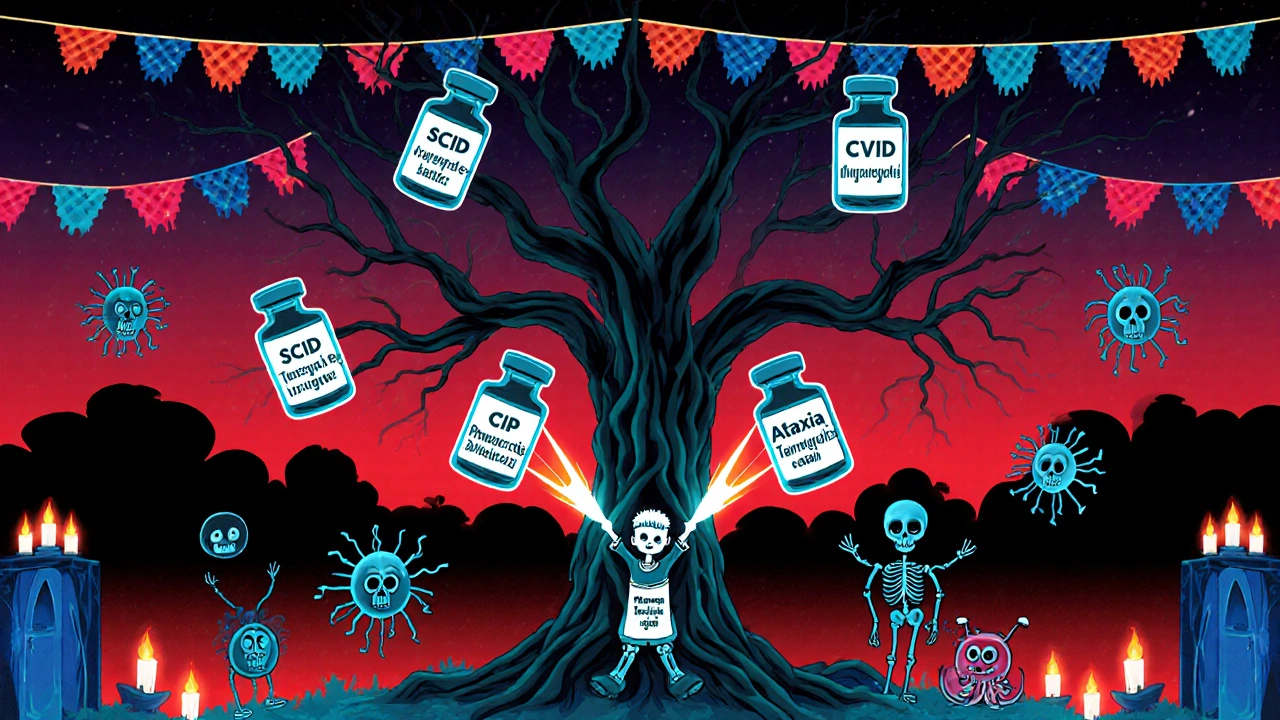When a child keeps getting sick-ear infections, pneumonia, sinus infections-it’s easy to blame daycare, bad luck, or a weak immune system. But when infections keep coming back, don’t just wait it out. Recurrent infections can be the earliest and most telling sign of an underlying immune disorder. In fact, up to 1 in 1,200 people in the U.S. have a primary immunodeficiency (PID), and many aren’t diagnosed until years after symptoms start. The key isn’t just how often someone gets sick-it’s what kind of infections, how severe they are, and whether standard treatments fail.
When Is a Recurrent Infection a Red Flag?
Not every cold or ear infection means something’s wrong. Healthy kids can have 6 to 12 respiratory infections a year, especially before age 5. But there are clear patterns that go beyond normal. The American Academy of Allergy, Asthma & Immunology and the European Society for Immunodeficiencies agree on these red flags:- Four or more ear infections in one year
- Two or more serious sinus infections in one year
- Two or more pneumonias within 12 months
- Persistent oral thrush after age 1
- Deep skin or organ abscesses that keep coming back
- Infections that don’t clear up after two months of antibiotics
- Need for intravenous antibiotics to treat infections
- Two or more deep-seated infections like septicemia or meningitis
- Failure to gain weight or grow normally
- A family history of immune problems
These aren’t vague suggestions-they’re clinical thresholds backed by data. For example, oral thrush after age 1 has an 89% specificity for antibody deficiency. That means if a child still has white patches in the mouth after turning one, and antibiotics didn’t help, it’s far more likely to be an immune issue than a simple yeast overgrowth.
What Doctors Look For During the Exam
A physical exam can give early clues. Some immune disorders have visible signs. If a child has no tonsils or lymph nodes, that’s a major red flag-78% of children with severe combined immunodeficiency (SCID) show this. Skin changes matter too. Telangiectasias (tiny red blood vessels on the skin) are seen in 95% of cases of ataxia-telangiectasia. Poor growth is another signal: 63% of children with PIDs fall below the 5th percentile for height and weight.Doctors don’t just count infections-they look for patterns in the bugs causing them. Infections with unusual organisms like Pneumocystis jirovecii, Cryptosporidium, or persistent Candida are absolute red flags. These are opportunistic pathogens that rarely harm healthy people. If a child gets one of these, it’s not a coincidence-it’s a warning.
Basic Lab Tests to Start the Workup
The first step in evaluating recurrent infections is simple blood work. A complete blood count (CBC) with manual differential is the starting point. In children over 1 year, a lymphocyte count under 1,500 cells/μL suggests a T-cell problem. In infants under 1 year, anything below 3,000 cells/μL is concerning.Next, immunoglobulin levels: IgG, IgA, and IgM. But here’s where most providers get tripped up-these numbers change with age. At 3 months, a normal IgG level is around 243 mg/dL. By age 5, it should be 700-1,600 mg/dL, just like adults. If an 8-year-old has an IgG of 420 mg/dL, it might look “normal” on a generic lab range, but it’s dangerously low for their age. That’s how some cases of Common Variable Immunodeficiency (CVID) get missed.
Flow cytometry for lymphocyte subsets (CD3, CD4, CD8, CD19, CD56) tells you if the body is making enough T cells, B cells, or natural killer cells. A CD3+ T-cell count below 1,000 cells/μL in a child over 2 is abnormal and needs urgent follow-up.

Testing Antibody Function-The Gold Standard
Measuring IgG levels alone isn’t enough. A person can have normal IgG but still can’t make antibodies when they need them. That’s why vaccine challenge testing is critical.Doctors check antibody responses to vaccines given in the past few months. For protein antigens like tetanus or diphtheria, they measure IgG levels 4-6 weeks after vaccination. Protective levels are ≥0.1 IU/mL. For polysaccharide antigens like pneumococcal vaccines, they wait 4-8 weeks and look for ≥1.3 μg/mL. If the body doesn’t respond, it’s not just low antibodies-it’s a functional failure.
CVID diagnosis requires three things: IgG under 400 mg/dL, low IgA or IgM, and a poor response to vaccines. Many patients are misdiagnosed as having chronic bronchitis or asthma because their IgG is just above the “normal” cutoff-but still far too low for their age.
What Else Could It Be? Ruling Out Mimics
Before jumping to a diagnosis of immunodeficiency, doctors have to rule out other causes. About 43% of children with recurrent infections have anatomical problems, not immune ones. Cystic fibrosis accounts for 12% of cases. Chronic sinusitis from blocked nasal passages makes up another 31%. Inhaled foreign bodies-like a small toy part or peanut-cause 18% of recurrent pneumonias in kids.Even more surprising: up to 30% of patients labeled with CVID actually have a secondary cause. Autoimmune diseases like lupus, certain cancers, or medications like steroids or biologics can suppress antibody production. Giving IVIG to someone with a drug-induced low IgG won’t fix the root problem-and could mask a cancer or autoimmune disorder.
The American College of Physicians warns: don’t start immunoglobulin replacement without proof of functional antibody failure. One study found 22% of patients received IVIG unnecessarily-costing thousands and exposing them to avoidable risks.

Testing Logistics and Common Mistakes
Timing matters. If a child got a live vaccine (like MMR or varicella) in the last 4 weeks, antibody tests could be falsely high. Inactivated vaccines (like DTaP or flu shots) need at least 8 weeks before testing. Polysaccharide and conjugate pneumococcal vaccines must be spaced at least 6 months apart.One of the biggest mistakes? Mistaking transient hypogammaglobulinemia of infancy (THI) for CVID. THI happens in 2-5% of babies-it’s temporary. IgG levels dip around 6 months and recover by age 2-3. But 41% of pediatricians in one survey started IVIG for these kids anyway. That’s unnecessary, expensive, and potentially harmful.
New Tools and Faster Diagnosis
In 2023, the FDA approved next-generation genetic panels like StrataID Immune, which tests 484 immune-related genes. These panels find the genetic cause in 35% of suspected PID cases-double the rate of older tests. Newborn screening for SCID is now mandatory in 38 U.S. states, up from 26 in 2018. Babies diagnosed before 3.5 months have a 94% survival rate. Those diagnosed later? Only 69% survive.AI tools are coming fast. The NIH is testing algorithms that predict specific immunodeficiencies using routine lab results-with 92% accuracy in early trials. Within five years, whole exome sequencing may become the first test for suspected PIDs, cutting diagnostic delays from years to weeks.
Why This Matters
The average time to diagnose a PID used to be 9.2 years. Thanks to awareness campaigns like the Jeffrey Modell Foundation’s 10 Warning Signs, that’s dropped to 2.1 years in centers following standardized protocols. Early diagnosis means fewer hospital stays, less lung damage from repeated pneumonia, and better long-term outcomes.It’s not about being overly cautious. It’s about recognizing patterns others miss. A child who gets pneumonia twice in a year isn’t just unlucky. A toddler with thrush after age 1 isn’t just having a yeast flare-up. These aren’t normal. They’re signals. And when you listen to them, you can change a life.
How many ear infections are too many for a child?
Four or more ear infections in one year is a red flag for possible immunodeficiency. Healthy children may have up to 6-8 infections annually, especially under age 5, but recurring infections that require antibiotics or lead to hearing loss should prompt evaluation. The key is not just frequency, but severity and response to treatment.
Can adults have primary immunodeficiency too?
Yes. Many people are diagnosed in adulthood, especially with Common Variable Immunodeficiency (CVID), which often shows up between ages 20 and 40. Adults with recurrent sinusitis, pneumonia, or gastrointestinal infections from unusual pathogens should be tested. CVID accounts for 68% of antibody deficiencies diagnosed in adults.
Is IVIG always the answer for recurrent infections?
No. Intravenous immunoglobulin (IVIG) is only recommended after confirming a functional antibody deficiency through vaccine response testing. Giving IVIG without this evidence can mask underlying conditions like cancer or autoimmune disease. Studies show 22% of patients receive IVIG unnecessarily.
What does failure to thrive mean in this context?
Failure to thrive means a child’s weight and height fall below the 5th percentile for their age and sex, and they aren’t growing normally despite adequate nutrition. In immunodeficiency, chronic infections and gut inflammation from pathogens like Giardia or Cryptosporidium can impair nutrient absorption. This is seen in 63% of pediatric PID cases.
Can a normal CBC rule out immunodeficiency?
No. A normal CBC doesn’t rule out immunodeficiency. Many patients with antibody deficiencies like CVID have normal white blood cell counts. The problem isn’t the number of cells-it’s whether they work. Immunoglobulin levels and vaccine response tests are needed to detect functional problems.
What’s the difference between primary and secondary immunodeficiency?
Primary immunodeficiency is inherited and caused by genetic defects in immune cells. Secondary immunodeficiency is acquired-caused by things like HIV, chemotherapy, malnutrition, or long-term steroid use. Treatment differs: primary PIDs may need lifelong IVIG or stem cell transplant; secondary causes require treating the underlying condition.
Should I get my child tested if a sibling has immunodeficiency?
Yes. Family history is one of the top red flags. Many PIDs are inherited, especially X-linked disorders like X-linked agammaglobulinemia, which affects 85% of pediatric antibody deficiency cases. If one child has a PID, siblings should be evaluated-even if they seem healthy-because early detection saves lives.
How long does it take to get a diagnosis?
With a structured workup following AAAAI guidelines, diagnosis takes about 112 days on average. Without a clear plan, it can take over a year-and sometimes up to 9 years. Early testing, proper lab interpretation, and avoiding misdiagnosis are the biggest factors in reducing delays.


Sean Hwang
November 14, 2025 AT 01:13my kid had 4 ear infections last year and i just thought it was daycare drama. turns out we were lucky we caught it early. doc ordered the IgG test and yeah, his levels were way low for his age. we started IVIG and he hasn't been sick since. honestly, if you're seeing the same infections over and over, don't just wait it out. get it checked.
Barry Sanders
November 15, 2025 AT 08:04Stop giving IVIG like candy. 22% of these cases are misdiagnosed. You're just masking a cancer or autoimmune disorder. This post is dangerous misinformation dressed up as medical advice.
Chris Ashley
November 16, 2025 AT 14:28bro i had thrush at 3 and my mom took me to 3 different docs and they all said 'it's just yeast' lol. then at 12 i got pneumonia 3x in 8 months and someone finally ran the labs. turns out i had CVID. you guys need to stop being lazy. it's not just 'kids get sick'.
kshitij pandey
November 17, 2025 AT 12:55as someone from india, i can tell you this is so important. so many parents here think fever and cough = normal. my cousin's son had 7 pneumonias by age 4 and they thought he was just 'weak'. finally got him tested after a neighbor who's a nurse pushed for it. now he's on treatment and thriving. don't ignore the signs, family. early detection saves lives.
Brittany C
November 17, 2025 AT 18:14It's critical to recognize that IgG reference ranges are age-dependent, and misinterpretation of these values is a pervasive diagnostic pitfall in primary care settings. The absence of lymphopenia on CBC does not preclude humoral immunodeficiency, as demonstrated in CVID cohorts. Functional antibody assays remain the diagnostic gold standard.
Sean Evans
November 18, 2025 AT 09:19OMG I KNEW IT. My sister got IVIG for 5 years and then got pancreatic cancer. They NEVER checked for autoimmune stuff. This is why people die. You're all just following the playbook like sheep. 😡💉🩸
Anjan Patel
November 19, 2025 AT 19:20What kind of irresponsible doctor gives IVIG without checking vaccine response? This isn't 1990 anymore. We have genetic panels that can find the root cause in weeks. Yet people still treat symptoms like magic bullets. Pathetic. This is why medicine is broken.
Scarlett Walker
November 20, 2025 AT 11:29my daughter had thrush past 1 and i just thought it was from antibiotics. i didn't know it was a red flag until i read this. now i'm getting her tested. thank you for sharing this. it could've been so much worse. you're doing good work.
Hrudananda Rath
November 20, 2025 AT 18:01It is an egregious oversight in contemporary medical pedagogy that the diagnostic criteria for primary immunodeficiency remain underemphasized in primary care curricula. The prevalence of misdiagnosis, particularly in pediatric populations, constitutes a systemic failure of clinical vigilance. One must question the epistemic foundations of modern diagnostic protocols.
Brian Bell
November 22, 2025 AT 07:09my nephew got SCID diagnosed via newborn screen. he's 2 now and running around like a champ. thank god they tested him. if they waited, he wouldn't be here. if you're in the US, ask your doc about the SCID screen. it's free and mandatory in 38 states. don't skip it. 🙏
Jane Johnson
November 23, 2025 AT 14:01While the data presented is statistically sound, one must consider the socioeconomic implications of widespread immunoglobulin testing. Not all families have access to specialists or genetic panels. Promoting aggressive testing without addressing healthcare disparities is ethically questionable.
Peter Aultman
November 24, 2025 AT 02:45Just want to say thank you for this. I'm a nurse and I've seen so many kids get misdiagnosed with asthma or allergies when it's actually CVID. I showed this to my team and we're now using the 10 warning signs checklist. Small change, big difference. Keep sharing this stuff.